Baruch College
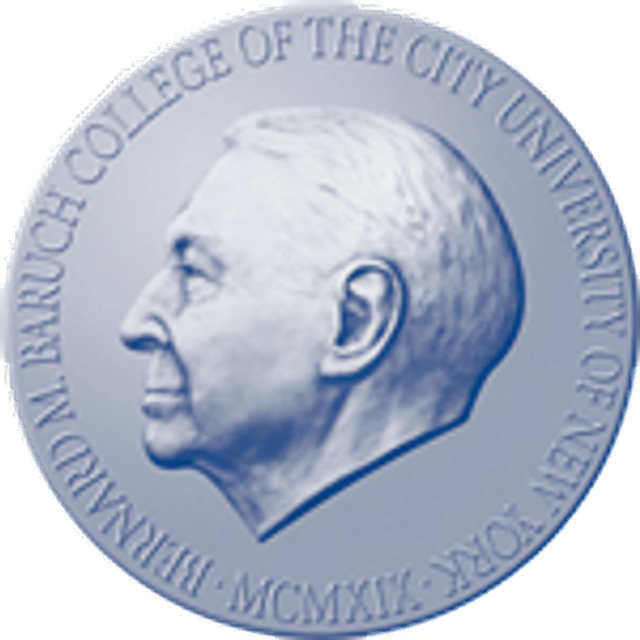
Baruch College

| Type | Public |
|---|---|
| Established | 1919 1968 as an independent college |
| Endowment | $197.3 million[1] |
| President | Mitchel Wallerstein |
| Provost | James McCarthy |
Academic staff | 1,221 |
Administrative staff | 699 |
| Students | 18,433 |
| Undergraduates | 15,254[2] |
| Postgraduates | 3,179 |
| Location | New York City (Gramercy Park, Manhattan) ,United States 40°44′25″N 73°59′00″W [77] |
| Campus | Urban |
| Colors | Blueand White |
| Athletics | Division III |
| Nickname | Bearcats |
| Affiliations | City University of New York |
| Mascot | Bearcat |
| Website | baruch.cuny.edu [78] |
 | |
Baruch College (officially the Bernard M. Baruch College) is a public college in New York City. It is a constituent college of the City University of New York system. Named for financier and statesman Bernard M. Baruch, the college operates undergraduate, masters, and Ph.D. programs through its Zicklin School of Business,[3] the Weissman School of Arts and Sciences, and the Marxe School of Public and International Affairs.
| Type | Public |
|---|---|
| Established | 1919 1968 as an independent college |
| Endowment | $197.3 million[1] |
| President | Mitchel Wallerstein |
| Provost | James McCarthy |
Academic staff | 1,221 |
Administrative staff | 699 |
| Students | 18,433 |
| Undergraduates | 15,254[2] |
| Postgraduates | 3,179 |
| Location | New York City (Gramercy Park, Manhattan) ,United States 40°44′25″N 73°59′00″W [77] |
| Campus | Urban |
| Colors | Blueand White |
| Athletics | Division III |
| Nickname | Bearcats |
| Affiliations | City University of New York |
| Mascot | Bearcat |
| Website | baruch.cuny.edu [78] |
 | |
History
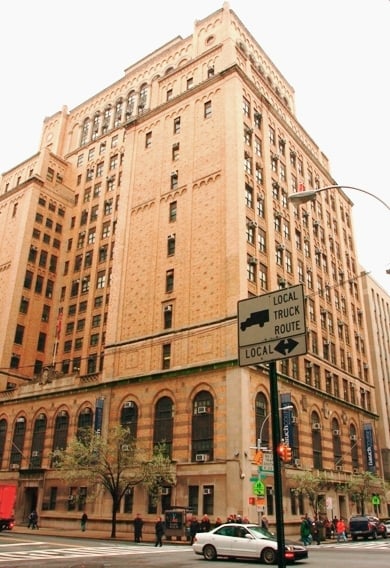
The original 23rd Street Building, still in use
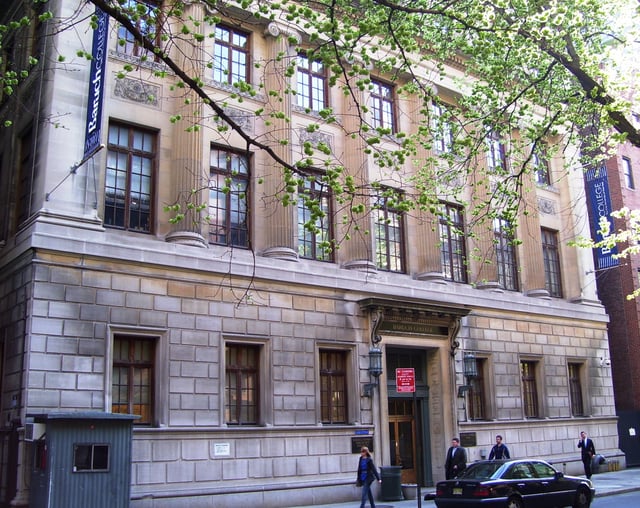
Steven L. Newman Hall at 137 East 22nd Street was built as one of the first Children's Courts in the U.S. (1912–1916).[4]
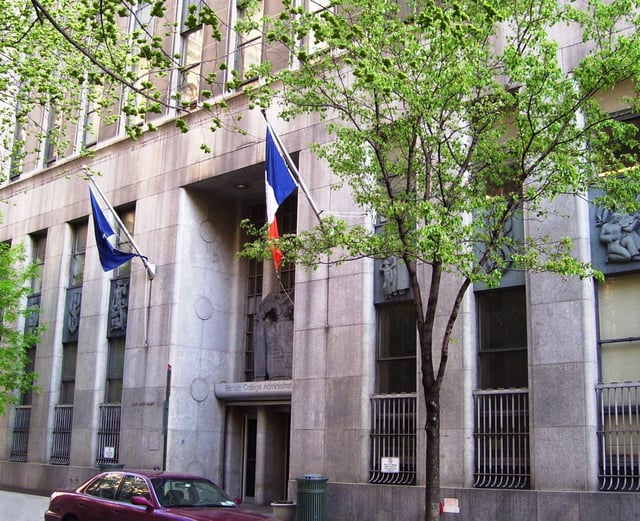
The Art Deco Administrative Center at 135 East 22nd Street was built in 1937–1939 as the Domestic Relations Court Building, and was connected to the Children's Court next door.[5]
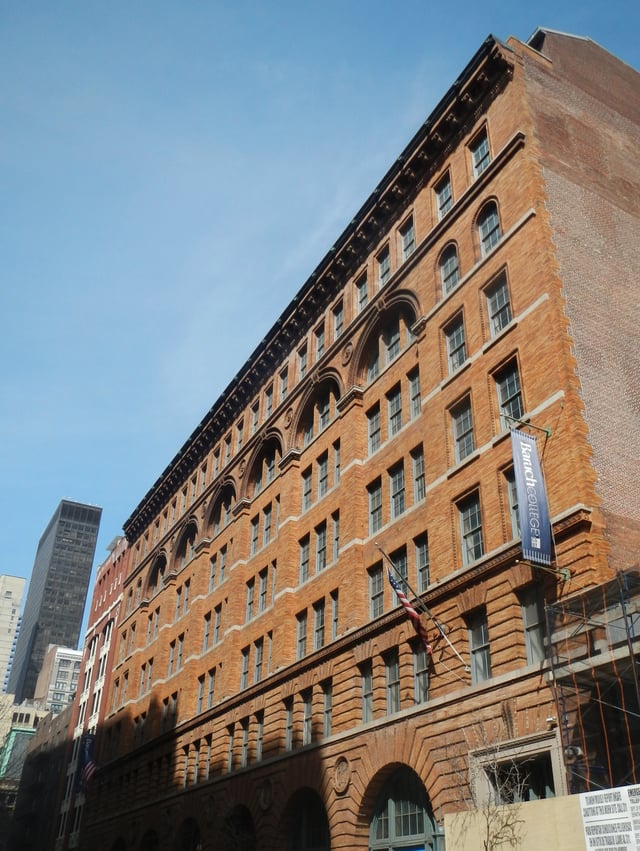
151 East 25th Street
Baruch is one of CUNY's senior colleges. It traces its roots back to the 1847 founding of the Free Academy,[6] the first institution of free public higher education in the United States. The New York State Literature Fund was created to serve students who could not afford to enroll in New York City’s private colleges. The Fund led to the creation of the Committee of the Board of Education of the City of New York, led by Townsend Harris, J.S. Bosworth, and John L. Mason, which brought about the establishment of what would become the Free Academy, on Lexington Avenue in Manhattan.
The Free Academy became the College of the City of New York, now The City College of New York (CCNY). In 1919, what would become Baruch College was established as City College School of Business and Civic Administration.[7] On December 15, 1928, the cornerstone was laid on the new building which would house the newly founded school. At this point, the school did not admit women. At the time it opened it was considered the biggest such school for the teaching of business education in the United States.[8]
By the 1930s, women were allowed into the School of Business. The total enrollment at CCNY reached an all-time high of 40,000 students in 1935, and the School of Business had an enrollment of more than 1,700 students in the day session alone. In 1953, it was renamed the Baruch School of Business in honor of Bernard Baruch, after an 1889 graduate of CCNY who went on to become a prominent financier and adviser to two presidents. In 1961, the New York State Education Law established the City University of New York (CUNY) system. In 1968, the Baruch School of Business was spun off as Baruch College, an independent senior college in the City University system.
The first president of the new college (1969–1970) was the previous Federal Secretary of Housing and Urban Development Robert C. Weaver. In 1971, the college appointed Clyde Wingfield, a noted educator, as its president. He was succeeded by economist Joel Edwin Segall in 1977. Segall recruited several well-known faculty members to the School of Business and established the college's permanent home on Lower Lexington Avenue.[9] Matthew Goldstein was president of the school from 1991 to 1998 (he later went on to serve as the Chancellor of CUNY from 1999 to 2013). He was responsible for raising admissions requirements and creating the School of Public Affairs in 1994. Edward Regan, former comptroller of New York state, served as president from 2000 to 2004. During his tenure, test scores rose, student retention rates increased, and many new faculty members were hired.[10] In 2001, the Vertical Campus opened and Baruch accepted its first students from the CUNY Honors College, now known as the Macaulay Honors College. The college also implemented a common core curriculum for all undergraduates.
Baruch received donations from alumni, the Vertical Campus, 23rd Street building, and Performing Arts complex, (renamed in honor of the three largest donors), respectively.[11] Alumni giving has increased under "Baruch Means Business," a $150 million capital campaign.[12] In August 2009, Waldron resigned from her position to become a University Professor at the Graduate Center. Stan Altman, the former dean of the School of Public Affairs from 1999 to 2005, was named interim president.[13]
On February 22, 2010, Dr. Mitchel Wallerstein, Dean of the Maxwell School of Citizenship and Public Affairs at Syracuse University, was appointed as the next President of Baruch College. He took office on August 2, 2010.[14]
Larry Zicklin, who endowed the Zicklin School of Business with an $18 million gift in 1997, is currently a Clinical Professor at Stern School of Business at New York University and teaches courses in Corporate Governance and the Management of a Financial Business at Stern. Zicklin is also a Senior Fellow at the Wharton School at the University of Pennsylvania.
Presidents of Baruch College
| President | Tenure | |
|---|---|---|
| Robert Weaver | 1968–1970 | |
| Clyde Wingfield | 1971–1976 | |
| Joel Segall | 1977–1990 | |
| Joyce Brown (interim) | 1990–1991 | |
| Matthew Goldstein | 1991–1998 | |
| Lois S. Cronholm (interim) | 1998–1999 | |
| Sidney Lirtzman (interim) | 1999–2000 | |
| Edward Regan | 2000–2004 | |
| Kathleen Waldron | 2004–2009 | |
| Stan Altman (interim) | 2009–2010 | |
| Mitchel Wallerstein | 2010–present |
Academics
The college is composed of three academic schools, the Zicklin School of Business, the Weissman School of Arts & Science, and the Marxe School of Public Affairs.
The Zicklin School of Business grants a Bachelor of Business Administration (BBA) degree in 19 different business related areas, a Masters of Business Administration (MBA) in 14 business related areas, and a Masters of Science (MS) in 8 business related programs.[16]
The Weissman School of Arts and Sciences grants a Bachelor of Arts (BA) degree in over 26 different arts and science related areas, a Masters of Arts (MA)in Corporate Communications and Mental Health Counseling, and a Masters of Science (MS) in Financial Engineering and Industrial Organizational Psychology.[17]
The Austin W. Marxe School of Public and International Affairs grants a Bachelor of Science (BS) degree in Public Affairs, a Masters of Public Administration (MPA) in 5 different public affairs-related areas and a Masters of Science in Education (MSEd) in Higher Education Administration.[18]
The college also houses several doctoral (Ph.D.) programs offered through the CUNY Graduate Center. They include Business (with specializations in Accounting, Finance, Information Systems, Marketing or Organizational Behavior) as well as Industrial and Organizational Psychology.[19][20] As of June 2013, the CUNY Ph.D. in Business degree is offered jointly by the Graduate Center and Baruch College.[21]
Campus
Lawrence and Eris Field Building
The Lawrence and Eris Field Building, also known as the 23rd Street Building, is still in use by the college today. The 23rd Street Building began renovation in 2013. The ten-year renovation project will finally bring the 23rd Street Building to twenty-first-century standards.[22] The building is home to the School of Public Affairs and several administrative offices.
Information and Technology / Library Building
The Information and Technology Building, opened in 1994, is located across East 25th Street from the Newman Vertical Campus.[23] It is home to the William and Anita Newman Library, featuring multiple floors with Wi-Fi access and designated "study-pod" areas. A 320-seat computer lab, the Baruch Computing and Technology Center, is on the sixth floor. The building also contains the offices of the Registrar, Undergraduate Admissions, Financial Aid and the International Student Center. It is colloquially known as the "Library Building" by students and staff.
Newman Vertical Campus
After decades of renting space for classrooms, the college began construction of what would later be called the Newman Vertical Campus in 1998. Named after businessman William Newman and inaugurated on August 27, 2001, the building is a 786,000-square-foot (73,000 m2), 17-floor building, which cost $327 million to erect.[24][25] It is now home to the Zicklin School of Business and the Weissman School of Arts and Sciences (the School of Public Affairs is housed in the Field Building).[24] It houses classrooms, faculty offices, additional computer labs for student use, along with the Athletic and Recreation Complex (ARC), Cafeteria, and Baruch Bookstore.[26] The Newman Vertical Campus was honored in 2003 by the American Institute of Architects with the highest award it offers to an individual building.[27] East 25th Street between Lexington and Third Avenue was renamed "Bernard Baruch Way", and the college now uses the Vertical Campus as its official address.
Campus location
The College is located between East 22nd and 25th Streets in Manhattan, along Lexington Avenue. The campus is served by the following transportation:
New York City Subway: the 23rd Street and 28th Street subway stations at Park Avenue, served by the 6 and <6> trains.[28]
MTA Regional Bus Operations' M1, M2, M3, M9, M15, M15 SBS, M23 SBS, M34A SBS, M101, M102 and M103 routes[29]
Academic centers and institutes
Baruch College Survey Research[30]
CCI – Corporate Communication International[31]
CUNY Institute for Demographic Research[32]
Center for Educational Leadership[33]
Center on Equality, Pluralism and Policy[34]
Lawrence N. Field Center for Entrepreneurship[35]
Jewish Studies Center[36]
Steven L. Newman Real Estate Institute[37]
New York Census Research Data Center[38]
Center for Nonprofit Strategy and Management[39]
Center for the Study of Business and Government (CSBG)[40]
The Bernard L. Schwartz Communication Institute at Baruch College is an academic service unit and faculty development program. It supports educational technology and communications instructional projects in the college.[41]
The Starr Career Development Center, named after the Starr Foundation, provides career services to all Baruch College undergraduates and alumni with bachelor's degrees from Baruch.[42]
Subotnick Financial Center: The Subotnick Financial Services Center, opened in 2000, provides a simulation of practical trading experience. Its centerpiece is the Bert W. and Sandra Wasserman Trading Floor.[43]
Center for Teaching and Learning[44]
Computer Center for Visually Impaired People[45]
Weissman Center for International Business[46]
Robert Zicklin Center for Corporate Integrity[47]
Partnerships
Baruch College's Zicklin School of Business: has established a corporate-university partnership with JP Morgan Chase.[48] maintains a joint J.D./M.B.A. program with Brooklyn Law School and New York Law School.[49]
Baruch College Campus High School is a New York City public high school affiliated to the college.
The Executive Master of Science in Finance, and Executive Master of Science in Marketing programs at the American Graduate School in Paris are affiliated with Baruch College.[50]
Student life
WBMB Baruch College Radio currently provides around the clock radio broadcasts via their website stream and local FM frequency 94.3.[51] The Ticker[52] has been the student newspaper since 1932. The school is home to business organizations, including large chapters of such national and international organizations such as ALPFA (The Association of Latino Professionals in Finance & Accounting), AIESEC, Toastmasters, Roller Hockey Club,[53] Alpha Kappa Psi, American Humanics, United Chinese Language Association, InterVarsity Christian Fellowship, and Golden Key.[54]
Athletics
Baruch College teams participate as a member of the National Collegiate Athletic Association's Division III. The Bearcats are a member of the City University of New York Athletic Conference (CUNYAC). Men's sports include baseball, basketball, cross country, soccer, swimming & diving, tennis and volleyball; while women's sports include basketball, cross country, dance team, softball, swimming & diving, tennis and volleyball.
Admissions
Baruch's undergraduate admissions are considered to be "Very Selective" by College Board.[55] In the Fall of 2013, over 19,400 students applied for admissions and only 5,000 were admitted with an acceptance rate of 27%. Baruch follows a holistic admissions process by considering teacher recommendations, application essay, and extracurricular activities, in addition to standardized test scores and GPA.
Rankings
Baruch College has been ranked by multiple sources, including:
In its annual "Social Mobility Index" for 2015, CollegeNet ranked Baruch #1 in the country, among more than 900 schools considered, in providing social mobility for students.[56]
Washington Monthly ranked Baruch #1 in the Northeast in 2015 in providing "Best Bang for the Buck."[57]
Entrepreneur magazine and Princeton Review ranked Baruch #5 in 2018 among colleges for its undergraduate entrepreneurship program,[58] and #10 for the graduate school.[59]
Forbes ranked Baruch #9 in the country among "Best Value Schools" for 2019.[60] The magazine also ranked Baruch #55 nationally among "Best Business Schools."[61]
In 2015, Business Insider recognized Baruch as #19 in its ranking of the 25 business schools that offer the best value.[62]
U.S. News & World Report ranked Baruch 20th in 2017 among Regional Universities in the North.[63] The magazine also ranked Baruch #4, Most Ethnically Diverse (in the North Region); #5, Top Public Schools (in the North Region); #1, Least Debt (in the North Region); #15, City Management and Urban Policy; #29, Health Care Management; #35, Accounting; #45, Top Public Affairs Schools; #61, Best Undergraduate Business programs; #66, Best Part-time MBA.[64][65]
U.S. News & World Report, in its 2020 ranking of "Best Business Schools," listed Zicklin as #52 nationally. [66]
Notable people
Alumni
Before 1968, alumni were officially alumni of the City College of New York.
William F. Aldinger III ('69), Chairman & CEO, HSBC North America Holdings
Egemen Bağış (MPA '96), Former minister for European Union Affairs, Turkish politician
Jack Barsky ('84), German-American author, IT specialist
Abraham Beame ('28), 104th Mayor of New York City
Anthony Chan ('79), Chief Economist, JP Morgan Chase Bank, N.A.
Akis Cleanthous (BBA '88), Former Chairman of the Cyprus Stock Exchange.[67]
Monte Conner ('86), Senior Vice President of Roadrunner Records, A&R Dept
Fernando Ferrer (MPA '04), Former Chairman of MTA (New York)
Michael Freeman (MBA '70), American inventor
Buddy Freitag (1953), Broadway producer (Porgy and Bess, Nice Work If You Can Get It)[68]
Michael Grimm ('94), Member of United States House of Representatives for New York's 13th congressional district
Sidney Harman ('39), Founder and Chairman Emeritus of Harman International Industries
Carl Heastie (MBA '07), 120th Speaker of the New York State Assembly
Robert Holland (MBA '69), Former President and CEO of Ben & Jerry's
Immortal Technique (dropped out), hip hop recording artist and activist
Tsvetta Kaleynska (EMPA ’15), Bulgarian author, TV personality
Mayuri Kango (MBA '07), Indian actress, Head of Industry at Google India
James Lam ('83), Author, Former Chief Risk Officer of GE Capital
Ralph Lauren (dropped out), Chairman of Ralph Lauren Corporation, Fashion designer Polo Ralph Lauren
Dennis Levine, Prominent player in the Wall Street insider trading scandals of the mid-1980s
Jennifer Lopez, (dropped out) American actress, singer, dancer and producer
Melissa Mark-Viverito (MPA '96), Speaker of the New York City Council
Adam Neumann (BBA '17), Co-founder and CEO of WeWork
Daniel A. Nigro, Commissioner of the New York City Fire Department (FDNY) [69]
Oscar N. Onyema (MBA '98), CEO of the Nigerian Stock Exchange (NSE)
Prince (Omubiito) Solomon Michael Okwiri Adyeri Ishagara, Omukama of Kingdom of Toro
Carlos D. Ramirez (1946–1999), Publisher of El Diario La Prensa.[70]
Albert Seedman ('41), First Jewish chief detective of the New York City Police Department
Martin Shkreli ('04), Founder and Former CEO of Turing Pharmaceuticals[71]
Upton Sinclair, American author who achieved popularity in the first half of the twentieth century, acquiring particular fame for The Jungle (1906)
Carl Spielvogel (BBA '57), Former U.S. Ambassador to Slovakia
Craig A. Stanley (MPA '99), Member of New Jersey General Assembly from 1996 to 2008
Stuart Subotnick (BBA '62), CEO of Metromedia; one of America's 500 wealthiest people in 2002
Eric Ulrich (MPA '16), Member of the New York City Council
George Weissman (BBA '39), Former Chairman and CEO, Philip Morris International
Larry Zicklin (1957), Former Chairman of the Board, Neuberger Berman
Faculty
Joel Brind, Professor of biology. Scientific advocate of the abortion–breast cancer hypothesis.
Mario Cuomo, Former 3-term Governor of New York State. Taught a public affairs seminar in the fall of 2008.[72]
John Liu, Former New York City Comptroller, mayoral candidate, and former member of the New York City Council. Teaches municipal finance and policy in the School of Public Affairs.[73]
Harry Markowitz, Professor of Finance, recipient of Nobel Prize in Economics (1990).
Donna Shalala, Secretary of Health and Human Services under the Clinton Administration. Taught politics at Baruch in the 1970s
Yoshihiro Tsurumi, professor of international business. scholar in multinational business strategy and national competitiveness